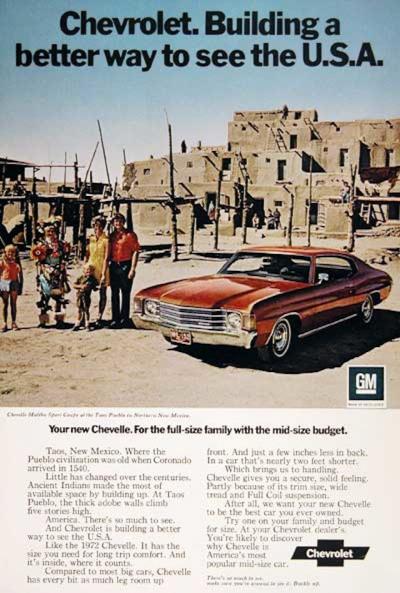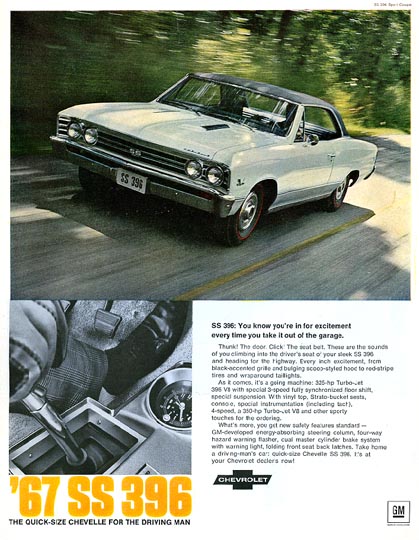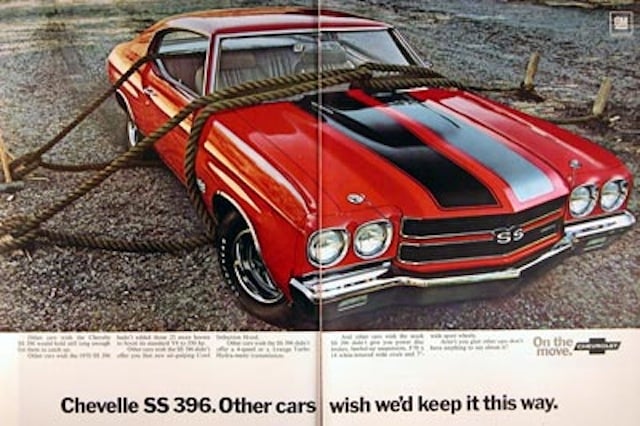 Hypothetical question: If you were to visit your local weekend car show, what’s the most common mid-size muscle car you would most likely see in attendance? The answer: Chevelle, and there’s a very good reason for that. The Chevelle was one of Chevrolet’s most popular models it has ever sold, it was one of the best selling cars of its era, and it remains to be a model that is coveted by hot rodders and collectors alike.
Hypothetical question: If you were to visit your local weekend car show, what’s the most common mid-size muscle car you would most likely see in attendance? The answer: Chevelle, and there’s a very good reason for that. The Chevelle was one of Chevrolet’s most popular models it has ever sold, it was one of the best selling cars of its era, and it remains to be a model that is coveted by hot rodders and collectors alike.
Introduced on September 26, 1963 and built between model years 1964 and 1977, the Chevrolet Chevelle was available in a wide array of body styles; everything from a two-door sport coupe to a four-door estate wagon. Chevrolet, after realizing that their Impala model was seemingly growing by the foot, needed a mid-size model to fit in between it and the recently-released compact Nova/Chevy II.
The new car would also serve as a direct competitor to Ford’s mid-size Fairlane model and would be built on the then-new A-body platform along with its siblings the Pontiac Tempest, the Oldsmobile Cutlass, and the Buick Skylark. The Chevelle would also have GM’s widest array of trim options, spanning from the barest of entry levels to the most plush Chevrolet available (besides the Impala).
When the Chevelle was originally released in 1964, the wheelbase measured 115-inches, the exact length as the ’55-’57 Chevy. That was no accident either, in fact, the high performance model known as the Super Sport was initially available with a 220hp 283ci V8, not unlike how the ’57 was. This caught the enthusiast’s attention, naturally.
However, while Chevrolet was busy living in the past and trying to be nostalgic with its customers, GM’s other divisions were looking ahead. But this didn’t last very long, and by mid-year 1964, the Chevelle’s top engine would become a much more effective 300hp 327, as a result of direct competition. Back in the day, brands under the same corporate roof would compete with each other, and Pontiac, now often credited today as the brand that created the first muscle car, (sorry guys, but it is true) released their new Tri-Power 389 GTO with 325hp.
Oldsmobile threw their hat in the ring next by offering its mid-size Cutlass 4-4-2 (four-barrel, four-speed, dual-exhaust) with a 310hp 330ci ‘plant, and even Buick would eventually join the party in 1965 with its Skylark GS, packing a 325hp 401ci “Nailhead” V8.
Now in true Chevrolet form, this wouldn’t do. So for the 1965 model year, the Bow Tie boys upped the ante again. For starters, they increased the horsepower rating of the 327 to 350hp, known as the RPO (Regular Production Order) L79 engine, which became the standard engine in the SS for ’65. Then they promptly got to work on what would become the first big block V8; the 396, aka, the “Mark IV.” Like in true hot-rod fashion, when in doubt, add more cubes! Thus, the Muscle car era was born.
Unfortunately for Chevy fans, there was a catch: only 201 Chevelle Super Sports were to be built with the newly developed engine in 1965. This rare and special engine would only come available as a complete option package. It would be known as RPO Z16, and the Z16 Chevelle would be unlike anything that came before it.
The engine, the behemoth that it was, came in the form of a 375hp 396 dubbed the L37. Complimenting this healthy dose of increased horsepower, a whole host of cost effective-but-effective components lifted right from the Chevy parts bin would be called upon.
Starting with the foundation, the more rigid, box-style frame from the convertible version of the Chevelle was used, while a narrowed, heavy duty rear axle and power brake system was borrowed from the full-size Impala.
The Z16 received a heavy duty suspension to improve handling and traction, and a Muncie 4-speed manual transmission was used to provide the driver with a more personalized driving experience. The Muncie was the one and only available gearbox for the Z16 Chevelle.
Chevrolet, wanting to get their point across that this was a driver’s car, and not a stripped-out racer, included every comfort and convenience Chevelle option available, including a tachometer, so the driver could keep a close eye on his revs that the L37 provided, a 160mph speedometer (presumably to help keep Johnny Law out of his or her rear view mirror), and deluxe front and rear seat belts to help keep occupants safe and in place, in the event that the vehicle’s owner ever decided to go crazy and engage in any extracurricular activities.
An AM/FM radio, padded dash, and a remote driver’s side mirror came as standard equipment as well.
The Z16 Chevelles looked very similar on the outside when compared to other ’65 Chevelles, save for the fact that they came equipped with the base model Chevelle 300’s taillights, and in between those lights sat a blacked out rear valance panel, which would eventually become standard on all Super Sport models, excluding the Camaro, throughout the rest of the ‘60s.
Now, as this is indeed a very special and very rare Chevelle, it isn’t the fastest or necessarily the most desirable Chevelle SS ever made. However, this car is considered to be genesis, and helped paved the way for muscle cars to come.
The 1966 model year brought several changes to the Chevelle; most notably, a complete redesign of the body. The SS became its own separate model that year. The Z16 package was dropped, along with the 283 and the 327 in the SS trim level, but the 396 remained, and in a much larger quantity with horsepower levels ranging from 325-375hp, respectively.
The following year, the updated body of ’66 would receive revised front and rear fascias, available front disc brakes and a new dual master cylinder for 1967. The restyled Chevelle also received a few safety enhancements, like a collapsible steering column and a warning light in the gauge cluster, in the event of brake failure.
This helped Chevrolet claim that the Chevelle was now safer than ever! My, how safety standards were low in the ‘60s. The 375hp version of the 396 was dropped early in the production year, though a total of 612 were built. The big block was still available in the 325hp and 350hp levels.
Nineteen-sixty eight delivered a whole new redesign for the Chevelle and it’s A-body cousins. Featuring a shorter wheelbase, the immensely popular long-hood, short-deck styling, along with a sculpted body and tapered front fenders, the new body style gave the Chevelle the muscular appearance that it rightfully deserved. The 375hp 396 option returned, again giving enthusiasts three levels of performance from their big block SS.
The Summer of Love saw the ’69 Chevelles roaming the streets. No longer a model of its own, the SS was reduced to a $347.60 option package. Engine choices remained stout, in the form of the 350hp and 375hp 396. The vent window had been removed, and a chrome, vertical bar stretched the entire width of the grille.
The taillights became larger and more flush with the body, providing a cleaner, and more attractive look for those who had the (mis)fortune of seeing the back of the Chevelle at traffic light encounters.
With the muscle car wars heating up, the gearheads inside GM borrowed a handful of the 425hp/427ci L72s from the Corvette and snuck it between the Chevelle’s frame rails.
Offered as the COPO (Central Office Production Order), it was a hush-hush program that wasn’t in the sales brochure, and most dealers didn’t even know about it resulting in only a couple of hundred being made.
The performance bar had been raised, and even Don Yenko of Yenko Chevrolet sold a total of 99 out of his Canonsburg, Pennsylvania dealership. Branded as the “Yenko S/C,” the performance of the rare Chevelle set the stage for what was in the works for the 1970 model year. Quarter-mile times in the low-13 second range were the norm for 427-equipped Chevelles, making the COPO and Yenko Chevelles very valuable today.
The first year of the nineteen-seventies marked a complete restyle of the Chevelle, still based off of the shortened wheelbase of the ’68-’69 model years. The 1970 model year also marked the pinnacle of the first muscle car era, and Chevrolet didn’t dissapoint!
The 396 was no longer the big dog, as it received a displacement increase to 402 cubic inches, by way of a .030” overbore. Though the the 396 was technically no longer a 396, the “396” call-outs remained on the fenders and the air cleaner of the Chevelle.
Not stopping there, two more engines joined the roster that year in the form of the LS-5 and LS-6 454. The LS-5 came equipped with 360hp, and the LS-6 ruled the streets with its 450hp and massive 500lb ft of torque.
The car also came with unique styling firsts, such as an available air scoop in a hood that already had cowl induction, which would grab air from the outside and force it into the carburetor as the driver would let off of the throttle.
It also included taillights that were mounted in the rear bumper, which would go on to be a staple in ‘70s automotive styling, as a result of federally mandated bumpers. But the ’70 Chevelle was the only car to really pull them off, especially when one ordered the SS, which had a black composite padding mounted on the bumper with an “SS”script on the right side.
Borrowing an existing theme from the Camaro, this was also the first year the Chevelle SS had the twin racing stripes adorned over the hood and trunk lid. It definitely helped the car stand out even more, however, a stripe delete option was available for those who preferred a more sedated appearance.
The LS-6 Chevelle was the highest-rated horsepower car of the era, and it’s the one car that nearly every muscle car owner can agree on being one of their all time favorites, it’s certainly one of mine.
The popularity of the ’70 Chevelle continues to grow today, as it is often used in movies and music videos, including as Vin Diesel’s hero car in the latest “Fast and the Furious” movie.
It’s also in countless video games and is quite often found in die-cast form. Much like how the ’65 Z16 was genesis, the ’70 LS-6 has been labeled the “ultimate muscle car”-by being the highest factory rated horsepower car of the era.
But as the old adage says, you can never have too much of a good thing, and 1970 would be the only year the LS-6 would be available in the Chevelle. It would only live in the Corvette for 1971 and though there were rumors of a few ’71 Chevelles leaving the factory with them, none have ever materialized.
 The ’71 Chevelle did receive a few changes however, including an option package based off the sport coupe called the “Heavy Chevy.” It was designed to be a low cost insurance beater, while offering any of the available V8 Chevelle engines save for the 454 as an option.
The ’71 Chevelle did receive a few changes however, including an option package based off the sport coupe called the “Heavy Chevy.” It was designed to be a low cost insurance beater, while offering any of the available V8 Chevelle engines save for the 454 as an option.
1971 marked the beginning of the end of the horsepower wars, as the government was cracking down on fuel guzzling, high compression engines. As a result horsepower figures dropped as well, which also resulted in the “net” horsepower ratings we still use today.
This was also the first time since 1965 that the Chevelle SS was available with a small block, even a 2bbl 350 version. Weirdly, the LS-5 managed to pick up an extra 5 horses over the previous year, as this was the one and only year that Chevrolet would advertise their engines in both “gross” and “net” form.
Styling was revised again, as the twin-headlamp setup from the previous years had now been reduced to a single headlamp arrangement, the front parking lamps/turn signals were moved to the corners of the fenders, and in the rear, the black composite piece on the bumper was dropped, and the single square tail lamps were replaced with twin round tail lamps like what you would get on the Corvette or Camaro of the same vintage.
1972 was essentially a carryover year, as the completely redesigned A-bodies planned for this model year were postponed an additional 12 months, thanks to a lengthy strike by the UAW. Horsepower dropped again, and the front parking lights were revised slightly. That’s pretty much it. Other than the fact that the Chevelle SS was now available with any V8, including the lowly 200hp 307.
The long awaited restyle of the Chevelle came in 1973, known as the “Colonnade” body style, and like before, it shared its new platform with its A-body cousins, including its sister car, the Monte Carlo.
This was also the same year as the first oil embargo, so naturally, things were looking pretty gloomy already for the performance enthusiast. In fact, the SS become a full blown appearance package this year, being available even on the wagon for Pete’s sake. But this would be become the last year for the SS option anyway, thankfully, as it would be replaced by the Laguna Type S-3 for 1974.
Disc brakes became standard equipment. Lagunas were also made available with swivel-style front bucket seats. Performance would continue to decline, making 1975 the final year for the big block Chevelle. The 454ci, 7.4L V8 produced a meager 235hp; today’s Japanese family cars have more power than that.
What would become the final year for the Chevelle, 1977 added up to a miserable year. The sole “performance” option was a 170 horsepower, four-barrel 350, while a Chevelle SE (Special Edition) offered front and rear spoilers, Turbine II wheels, special graphics and decals, front and rear sway bars, F41 sport suspension and a deluxe interior, resulting in 50 of these being built.
As GM downsized its intermediate models for 1978, the Chevelle name was dropped, leaving the Malibu as the nameplate for all models. Today, the Malibu name is synonymous with Chevrolet’s desperate attempt to compete with the Toyota Camry and Honda Accord, not exactly the platform to bring the fabled Chevelle back with. Today, the Chevelles of the past are the greatest symbol of Chevolet’s strength during these tumultuous years.





























